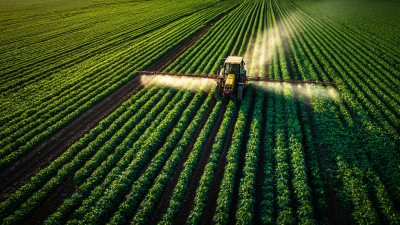 0551-68500918
0551-68500918 





In the farming world, using new and innovative Seed Treatments has really become a key part of boosting crop yields and making farming more sustainable. According to market research by Research and Markets, the global seed treatment industry was worth about $6.4 billion back in 2020, and it’s expected to grow to around $11.1 billion by 2026. That’s a pretty impressive annual growth rate of 9.3%. This just shows how important seed treatments are for protecting crops against pests and diseases while also helping farmers get better harvests. One company leading this charge is Innovation Meiland (Hefei) Co., LTD. They're all about developing cutting-edge pesticides and formulations that use advanced seed treatment techniques. Based out of Hefei, China, Meiland Stock is dedicated to creating smarter solutions to make agriculture more efficient and, ultimately, fight hunger on a global scale.

You know, these days, innovative seed treatment techniques are pretty much a must-have in modern farming. They give farmers a real edge when it comes to boosting crop yields and making plants more resilient. Basically, there are all sorts of biological and chemical treatments out there that help protect seeds from diseases, pests, and tough environmental conditions. When seeds are healthier from the get-go, it’s easier to get good germination rates and grow stronger plants—that's key if you wanna make the most out of your harvest, especially with so much competition these days.
What’s pretty cool is that these treatments aren’t one-size-fits-all. They can be tailored to specific crops and local conditions, helping plants grow better right from the start. For example, some seed coatings now include helpful microorganisms to boost nutrient absorption and keep soil healthy. Plus, with smart tech integrated into seed treatment processes, farmers can actually keep an eye on how their seeds are doing and tweak things on the fly. This means better resource use and less harm to the environment. All in all, jumping on these new techniques isn’t just about staying ahead; it’s about making farming more sustainable and efficient to meet the world’s growing food needs.
Lately, there's been some pretty exciting stuff happening with seed treatments — really essential tools to boost germination and, in turn, crop yields. According to a report from the International Seed Testing Association, using the right seed treatments can bump up germination rates by as much as 20%. That’s a big deal when you think about how it can seriously increase your farm’s productivity. Essentially, these treatments guard seeds against nasty pathogens and pests while encouraging healthier roots, giving your crops a stronger, better start.
If you're looking to get the most out of your seed treatment routine, a few tips might help. Incorporating fungicides, insecticides, and bio-stimulants can make a real difference. For example, a recent study showed that seeds treated with bio-stimulants had up to a 25% jump in early crop establishment. Not only does that translate into higher yields, but it also makes your crops tougher against environmental stressors.
**Tip:** When choosing seed treatments, go for products that boost both germination and overall plant health. It’s also a good idea to check your soil’s health before treatment — that way, you can tailor your approach and choose the best combo of products for your specific situation. Oh, and staying up-to-date with new tech and advancements in seed treatment can really help you get the most out of your crops.

Lately, biological agents have really started to play a big role in developing more sustainable seed treatments that help boost crop yields. Things like helpful bacteria, fungi, and natural compounds work with plants—forming kind of a friendly partnership—that helps plants take up nutrients better. Instead of relying so much on chemical fertilizers and pesticides, farmers are now inoculating seeds with these natural agents. It’s a win-win because it’s better for the environment and can still support healthy plant growth.
Plus, these biological treatments don’t just improve nutrient absorption. They also make seeds germinate faster and help plants fight off diseases and pests more effectively. For example, mycorrhizal fungi can really expand a plant’s root system, making it easier for the plant to find water and food. And some bacteria produce substances that keep nasty pathogens at bay. Incorporating these kinds of techniques could totally change farming—making it more eco-friendly and cost-effective. All in all, it’s a smarter way to grow crops, supporting a healthier planet while also increasing productivity.
This chart illustrates the effectiveness of various innovative seed treatment techniques in enhancing agricultural productivity, measured in terms of crop yield in tons per hectare.
Lately, seed treatments have been catching a lot of attention in farming circles. People see them as pretty cool tools to boost crop yields and overall productivity. But here’s the thing—whether they’re really worth it financially is a big deal for most farmers. The cost of these treatments can really vary a lot, depending on what kind you choose, the crop you’re growing, and where you’re located. Farmers need to weigh the extra expenses against the potential benefits to see if it’s a smart move.
When trying to figure out if seed treatments make sense for you, it’s a good idea to look at both the hard numbers—like better germination and fewer pests or diseases—and the less tangible stuff, like healthier soil and more sustainable farming practices. A lot of studies show that even if the upfront costs seem high, the long-term perks—like improved soil health, less need for harsh chemicals, and ultimately, bigger harvests—can really pay off. By digging into these details, farmers can make smarter decisions about whether to invest in seed treatments, making sure their money actually leads to real improvements on the farm.
| Seed Treatment Technique | Average Cost per Acre ($) | Increase in Yield (%) | Return on Investment (ROI) | Environmental Impact (1-5 scale) |
|---|---|---|---|---|
| Biological Seed Treatment | 25 | 20 | 200% | 4 |
| Chemical Seed Treatment | 30 | 15 | 150% | 3 |
| Hot Water Treatment | 20 | 10 | 125% | 5 |
| Coating with Nutrients | 15 | 25 | 300% | 4 |
| Organic Seed Treatment | 28 | 18 | 180% | 4 |
So, it looks like innovative seed treatments are really about to shake up farming as we know it. There are tons of exciting developments on the horizon, but one of the coolest trends right now is nano-encapsulation. Basically, this tech boosts how well nutrients and pesticides get delivered to the seeds. It’s like giving the seeds a targeted boost—cutting down waste, being kinder to the environment, and helping crops produce more. Using tiny nanoscale materials to wrap active ingredients ensures that the seeds get exactly what they need right from the start, helping them grow into strong, healthy plants right off the bat.
And on top of that, biostimulants are really catching on as a key part of the future for seed treatments. These are natural substances that can give seeds a leg up—improving germination and helping plants absorb nutrients better, while also making them tougher against stresses. As research keeps advancing, I wouldn’t be surprised if we see more plant-based biostimulants show up on farms, working alongside traditional pesticides to make everything more sustainable and effective.
Plus, innovations with beneficial microbes are also gaining traction. These tiny helpers can be added to seeds to improve soil health and support plants in dealing with climate stresses. All in all, these trends are pointing toward a more efficient, eco-friendly way to treat seeds—paving the way for a new wave of agricultural innovation. It’s pretty exciting to think about how much things could change in the coming years!

Implementing new and innovative seed treatment techniquesisn’t all smooth sailing—there are quite a few hurdles that can make it tricky to actually see the benefits in farming. One big issue is the really high cost of these fancy seed treatments. I read in a report by Mordor Intelligence that the global Seed Treatment Market is projected to hit around13.2 billion dollars by 2026—so, yeah, there's definitely a lot of money going into developing these technologies. But for small-scale farmers, that initial investment can be a real barrier because they often don’t have easy access to this kind of capital. Plus, it’s important to weigh the cost of treated seeds against the expected boost in yields—farmers need to see clear economic benefits for it to be worth it.
On top of that, there are regulatory challenges and safety standards that can slow things down. According to a report from the Food and Agriculture Organization (FAO), different regions have different rules, which can make getting new seed treatments approved quite complicated. Biological seed treatments, for example, often face extra scrutiny because folks want to be sure they’re safe for the environment and actually work in the long run. Overcoming these issues isn’t something one industry player can do alone—it takes teamwork between governments, researchers, and farmers to create a kind of streamlined process that boosts innovation but still keeps safety and sustainability in check.
: Seed treatments are innovative strategies used to enhance crop yields and overall productivity. They play a crucial role in improving germination rates and reducing pest and disease pressures.
Farmers assess the potential returns from seed treatments against the increased costs, considering both quantifiable benefits like higher yields and qualitative impacts such as improved soil health and sustainability.
Long-term benefits include enhanced soil fertility, reduced reliance on Chemical Pesticides, and ultimately, higher agricultural yields, despite potentially high initial expenses.
Future trends include the development of nano-encapsulation methods for targeted application of nutrients and pesticides, increasing the effectiveness while minimizing waste and environmental impact.
Biostimulants are organic substances that enhance seed germination and plant growth by improving nutrient uptake and stress resistance, and they are becoming increasingly popular in future seed treatments.
Microbial seed treatments involve introducing beneficial microorganisms to seeds, which can improve soil health and help plants become more resilient to climate-related stressors.
Many new seed treatment innovations, such as nano-encapsulation and biostimulants, aim to be more eco-friendly, reducing environmental impact while maximizing crop yields.
Farmers must weigh the initial investment costs against potential returns and may need to consider regional conditions and specific crop needs when deciding whether to adopt these technologies.
Yes, effective seed treatments can reduce reliance on chemical pesticides by enhancing plants' natural resistance to pests and diseases, promoting sustainability in agriculture.
Innovations like nano-encapsulation ensure that seeds receive optimal growing conditions right from germination, resulting in stronger and healthier plants.
Innovative seed treatments are really making a difference in today’s agriculture. They can significantly boost how well seeds germinate and lead to higher crop yields—pretty exciting stuff, right? Plus, these new techniques bring a bunch of benefits, like stronger resistance against pests and diseases, and they even support more sustainable farming methods by incorporating biological agents. And let’s not forget the cost side of things—many farmers find these treatments to be a smart investment because they often pay off in the long run.
Looking ahead, it’s clear that the seed treatment industry is on the brink of some cool innovations that could take agricultural productivity to the next level. But, of course, there are still hurdles to overcome when it comes to putting these new techs into practice. If we can tackle these challenges and maybe learn from innovative companies like Innovation Meiland (Hefei) Co., LTD., the agricultural world can keep evolving and really start to maximize the benefits of seed treatments. It’s an exciting time for farming, with lots of potential for positive change.







